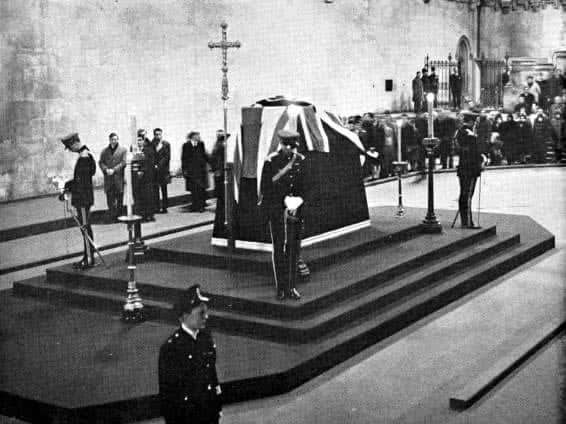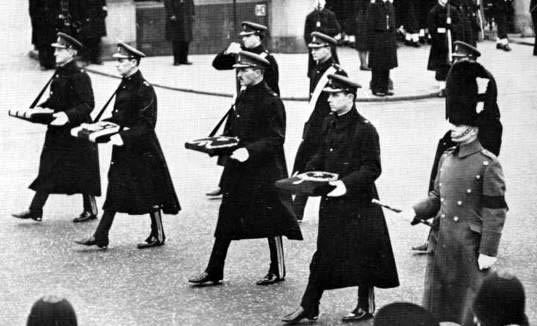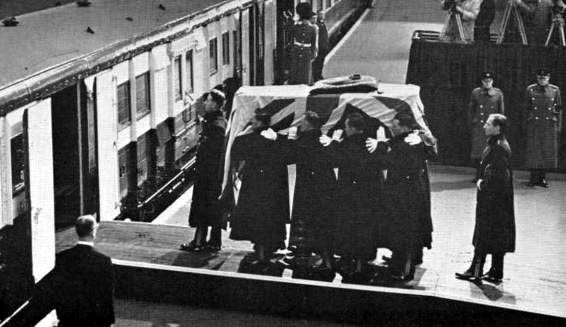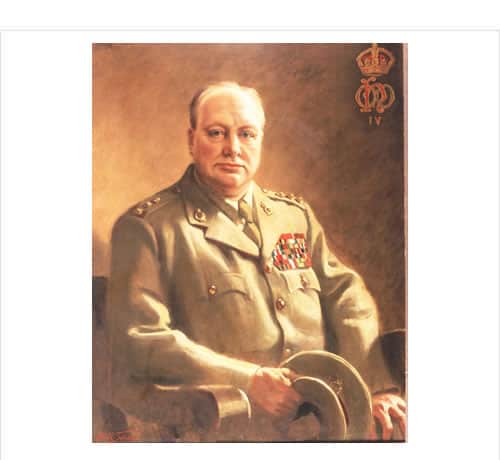Those of us who were honoured to take part in the funeral procession of our late Colonel will, perhaps, remember more vividly than any other single thing the sombre and wholly fitting beat of the drum as we slow marched between the ranks of a nation in mourning. When that day was over, some of us may have felt prouder than we had ever felt before. Some of those who watched but were not personally concerned with the arrangements expressed their satisfaction that everything had gone with such faultless and magnificent ceremony, as became so historic an occasion. But, of course, perfection was not achieved without preparation.
The regiment was charged with four duties. First, and this was a joint duty with the 17th/21st Lancers, we provided officers for the vigil party who watched over Sir Winston’s lying in State in Westminster Hall: secondly there was to be a party of officers in the procession itself to carry our Colonel’s insignia: thirdly (and here we are grateful for the intercession of Major Jaegar of the Irish Guards, formerly a 4th Hussar, on our behalf) a single regimental trumpeter would play Reveille during the actual service in St. Paul’s Cathedral: finally, the most honoured task of all, our bearer party would carry out the regiment’s last service, in charge of the coffin from Waterloo station to the resting place at Bladon.
The officers and soldiers chosen for these duties are listed below. It was on the morning of Sunday, 24th January 1965, that we assembled in London a few hours after the regiment’s most famed and beloved member had died. And here it should be said how grateful the regiment is to the 1st Battalion, Welsh Guards, for their kindness and helpfulness in looking after everyone concerned during their stay in Chelsea Barracks.

On 26th January Sir Winston’s body was taken privately to Westminster Hall where customarily only the Royal dead are so honoured. There his body was to lie in state for three days, guarded by watchers from the three services whilst the people filed silently by to pay their last respects to the saviour of his country. So began the duties of the Vigil Party. When the Watch was on duty there were four officers at the catafalque, one at each corner. a Watch Keeper at the top of the steps and a reserve officer in waiting. The Watches were mounted and dismounted by either the officer-in-charge (Lt Colonel J. F. Weston-Simons) or by his second-in-command (Lt Colonel R. D. Pitt). What was, perhaps, most memorable in this high, gaunt, timbered hall was the tapping of the sword upon stone to give order to the Watches, the sight of those mourning thousands, the contrast of the hall when empty of crowds on the morning of the funeral, and, above all. the stately dignity of the catafalque and its honoured burden.
Meanwhile, for the others-the bearer party, the trumpeter (Sgt King) and those who were to carry the insignia, these were days of preparation and rehearsal. At last, the day itself dawned. Shortly before a quarter to ten on 30th January, the coffin was taken by the bearer party of the 2nd Battalion, Grenadier Guards from the catafalque to the gun carriage. Our Watch Commander and the officers on duty slow marched with the coffin to the entrance of Westminster Hall and gave a final salute. The funeral had begun.
Those officers who were carrying Sir Winston’s decorations and banners were positioned immediately behind the Chiefs of Staff and in front of the gun carriage, and its entourage. The orders were given; the procession moved off; our Colonel’s last journey had started. During that long slow march, more perhaps than at any other time during this unforgettable day, we were conscious of a sense of occasion unequalled in our lives before and unlikely ever to be approached again. It was not altogether a feeling of sadness. Here was the great warrior, the regiment’s most renowned member, making his exit. but making it in a way that was as glorious as his life had been. The crowd eyed his campaign medals, his grand decorations and the banners of Warden of the Cinque Ports and the Spencer-Churchills. Many saluted them. St. Paul’s was reached and entered-the insignia laid gently in their places by the catafalque. The service began amidst the dense, silent gathering.

When the moment had been reached that the Last Post was played. it was done so superbly well by the trumpeter of the Household Cavalry that we held our breaths lest Reveille should be less faultlessly executed. We need not have worried. Sgt King rose to the occasion, as in our hearts we knew he would, and never can the stirring notes of the call have been more hopefully or triumphantly blown and heard. The service over, we stood on St. Paul’s steps whilst the coffin was borne once more to the gun carriage, and its majestic progress resumed. The Tower, the Thames, Waterloo, and waiting there was what the Duke of Norfolk was subsequently to describe as the finest bearer party he had ever seen.
Their loving care, their magnificent bearing, their solemn dignity will not be forgotten by those who saw them. For their commander. Captain De Morgan, the senior Warrant Officer. Mr Holberton, Regimental Sergeant Major, and each one of the eight stalwarts, darkly cloaked bearers, we have unstinted feelings of admiration and pride. They were in every way worthy of their great responsibility, and they accompanied Sir Winston until the last moment of this day, of all days, to be remembered.

As we dispersed again to our duties, we felt that we had for a short space been part of Britain’s history.
The Vigil Party
Lt Colonel J. F. Weston-Simons
Lt Colonel R. D Pitt
Major C. N. Jones
Major M. Wright
Capt M. D. Oliver
Capt R. B. Merton
Capt T. G. Williams
Capt T. P. Anson
Capt C. St. G. Rich
Capt B. L. G. Kenny
Capt M. D. White
Capt C. S. T. Darley
Lt C. E. Bowly
Lt A. J. Cramsie
Lt A. H. Fraser
17th/21st Lancers
Major M. G. Canning
Major M. E. A. Berryman
Capt A. J. Bateman
Capt N. M. Still
Capt C. B. R. Hale
Capt R. H. Swinburn
Capt R. S. Longsdon
Capt M. G. Wyatt
The Insignia Party
Lt Colonel J. M. Strawson
Major G. K. Bidie
Major T. W. Tilbrook
Major C. D. B. Troughton
Major J. L. Sutro
Major J. J. Graham
Major R. O. G. Wood
Major D. A. R. Murray-Brown
The Bearer Party
Capt B. W. de Morgan
WO I Holberton
WO II Williams
WO II Townson
WO II Barker
WO II Nunn
SQMS Booth
SSgt James
Sgt Webb
Sgt Smith
Sgt Hawksbee
Sgt Heesom
The Trumpeter
Sgt King
The Ranks are shown as they were on 30 January 1965.
(an extract from The Crossbelts 1966)


